- With standard equipment
- With safety pack
Find more information in the General Comments section of the assessment
Find more information in the Rating Validity tab of the assessment
- See More
- See More
- See More
- See More
- Good
- Adequate
- Marginal
- Weak
- Poor
 Passenger
Passenger
 Driver
Driver
 Rear Passenger
Rear Passenger
 Driver
Driver
 Car
Car
 Pole
Pole
 Rear Seat
Rear Seat
 Front Seat
Front Seat
- Good
- Adequate
- Marginal
- Weak
- Poor


Passenger
outboard
center
Fitted to the vehicle as standard
Not fitted to the test vehicle but available as option
Not Available
-
i-Size CRS
-
ISOFIX CRS
-
Universal Belted CRS
Easy
Difficult
Safety critical
Not allowed
| Seat Position | ||||
|---|---|---|---|---|
| Front | 2nd row | |||
| Passenger | Left | center | Right | |
| Maxi Cosi 2way Pearl & 2wayFix (rearward) (iSize) | ||||
| Maxi Cosi 2way Pearl & 2wayFix (forward) (iSize) | ||||
| BeSafe iZi Kid X2 i-Size (iSize) | ||||
| Maxi Cosi Cabriofix & FamilyFix (ISOFIX) | ||||
| BeSafe iZi Kid X4 ISOfix (ISOFIX) | ||||
| Britax Römer Duo Plus (ISOFIX) | ||||
| Britax Römer KidFix XP (ISOFIX) | ||||
| Maxi Cosi Cabriofix (Belt) | ||||
| Maxi Cosi Cabriofix & EasyBase2 (Belt) | ||||
| Britax Römer King II LS (Belt) | ||||
| Britax Römer KidFix XP (Belt) | ||||
Easy
Difficult
Safety critical
Not allowed
In the frontal offset test, readings of neck tension in the 10 year dummy, and of chest deceleration in the 6 year dummy indicated a marginal level of protection. Otherwise, protection was adequate or good. In the side barrier test, protection was good for all critical parts of the body. The front passenger airbag can be disabled to allow a rearward-facing child restraint to be used in that seating position. Clear information is provided to the driver and the system was rewarded. All of the restraint types for which the C3 is designed could be properly installed and accommodated in the car.
- Good
- Adequate
- Marginal
- Weak
- Poor

Head Impact 13.0 Pts
Pelvis Impact 6.0 Pts
Leg Impact 6.0 Pts
The protection offered by the bonnet to the head of a struck pedestrian was predominantly adequate. Poor results were recorded around the base of the windscreen and on the stiff windscreen pillars. The protection offered to the pelvis and to the legs were good, with maximum points scored in these areas of assessment.
- Good
- Adequate
- Marginal
- Weak
- Poor
| System Name | Speed Limit Recognition and Recommendation |
| Speed Limit Information Function | Camera based, subsigns supported |
| Warning Function | System advised |
| Speed Limitation Function | System advised (accurate to 5km/h) |
| Applies To | All seats | ||
| Warning | Driver Seat | Front Passenger(s) | Rear Passenger(s) |
| Visual | |||
| Audible | |||
|
|||
| System Name | Lane Departure Warning |
| Type | Lane Departure Warning |
| Operational From | 70 km/h |
| Warning | Audible and Visual |
| Performance | |
|
LDW Confirmation Test
|
Pass |
A seatbelt reminder system for the front and rear seats is standard on the C3. The speed assistance system uses a camera to detect what the limit is and informs the driver, who can then manually set the appropriate speed for the limiter. A lane assistance system is also standard equipment and warns the driver is the car is drifting out of lane.
- Specifications
- Safety Equipment
- Videos
- Rating Validity
Specifications
Tested Model Citroën C3 1,2 PureTech 82 FEEL, LHD
Body Type - 5 door hatchback
Year Of Publication 2017
Kerb Weight 1072kg
VIN From Which Rating Applies - all C3s
Class City and Supermini
Safety Equipment
Note: Other equipment may be available on the vehicle but was not considered in the test year.
Fitted to the vehicle as standard
Fitted to the vehicle as part of the safety pack
Not fitted to the test vehicle but available as option or as part of the safety pack
Not available
Not applicable
Videos
Rating Validity





Find more information in the General Comments section of the assessment
 Share
Share
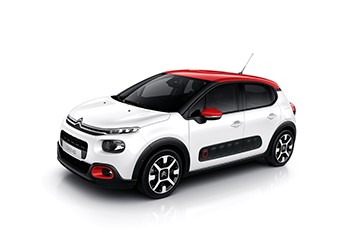
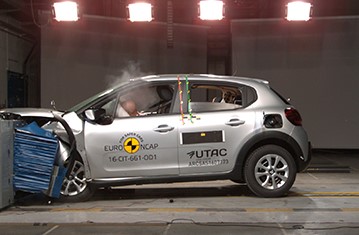
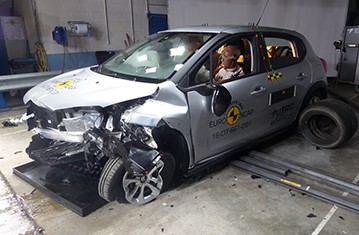
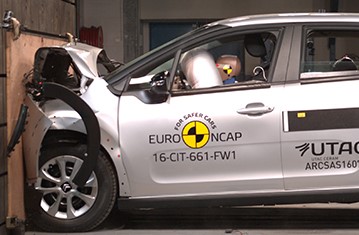
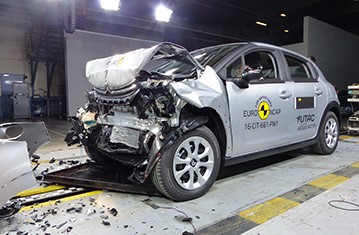
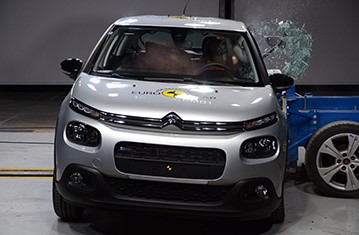
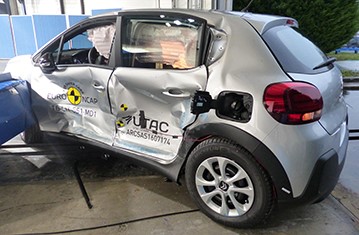
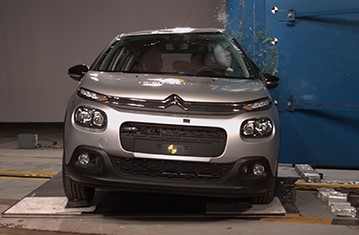
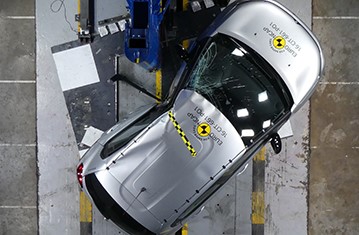



The passenger compartment of the C3 remained stable in the frontal offset test. Dummy readings indicated good protection of the knees and femurs for the driver and passenger. Citroën showed that a similar level of protection would be provided to occupants of different sizes and to those sat in different seating positions. In the full-width rigid barrier test, protection of the chest and neck was adequate for the driver and rear passenger, and that of other critical body areas was good. The C3 scored maximum points for its performance in the side barrier test, with good protection of all critical parts of the body. Even in the more severe side pole impact, protection of the chest was adequate and that of other body regions was good. Tests on the front seats and head restraints demonstrated good protection against whiplash injury in the event of a rear-end collision, and a geometric assessment of the rear seats showed good protection there, too. The C3 does not have an autonomous emergency braking system.